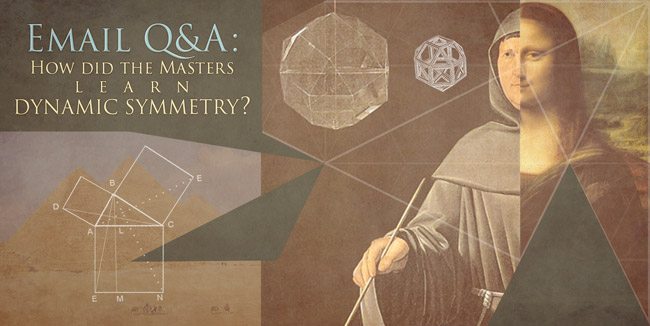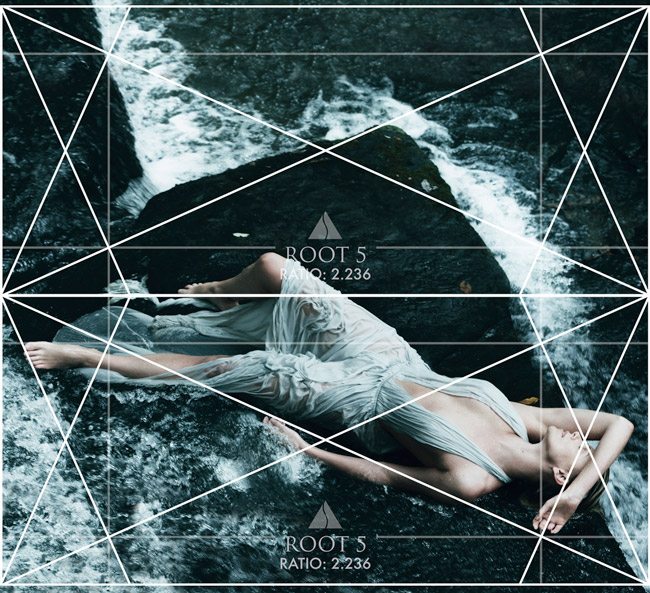Email Q and A: How Did the Masters Learn Dynamic Symmetry?

#437
Hey everyone, huge thanks for all of the support…you keep this site going! Today we have another Email Q &A where I help a fun member with a great question. He is curious of how the masters learned root rectangles and dynamic symmetry to create such masterful compositions. We’ll soon find out!
Here’s an example of Annie Leibovitz using two stacked root 5 rectangles to compose the model (see Day 222).
Email and Question
“Hey Tavis,
Ok so I learned about your site on facebook and checked it out and signed up to learn more. I read the first 20 or so articles and thought to myself this is a bunch of bull****. You draw enough lines on and image and of course things are going to line up. I did not visit the site for a couple of months and then saw my PayPal payment going out and decided to revisit the site. I read more…a lot more. I have recently had knee surgery and have a ton of time on my hands, such a luxury.
It really wasn’t until I saw the interview with Bresson that I really took notice (see Day 116). When asked how he composed his image he of course said geometry, I was hooked. I am on article 160 now and my God man have I learned a ton!!!!! S*** the virtual library is worth the price of admission.
I still have a hard time thinking on how I would compose my images given what I have learned. The roots really seem confusing but the analysis of images and paintings is helping. I get it I just don’t know how to apply them to my images yet. I am not a point and shoot guy I do take my time composing my images and I guess a lot of them are on the rule of thirds but there are plenty that are not. Have a look if you have some time. I have a bunch more that are not on my site but they are in my facebook albums.
I am on facebook as Tony Bunting shoot me a friend request if you would like. In 2013 I shot and posted an image a day for a year. This really makes you get creative because you don’t want to just do snapshots anyone can do, so I get creative. I only use Photoshop and Lightroom for basic adjustments. I have Photoshop but don’t use it…mainly Lightroom. Everything you see is done in the camera not software.
I am going back to school this fall and getting an AA in photography. I am sure that I could teach a thing or two with my instructors and will be sharing your site with them. I have two photography and two art classes this fall. One is drawing, I hope stick figures will be sufficient ha ha. I know that they are going to be teaching the rule of thirds as it is the easiest to teach and learn. I don’t know we will see and I will let you know. I hope it is more involved than that.
QUESTION: How did the masters learn the roots? They all seem to know it either consciously or unconsciously. They were not communicating with each other were they? Were there teachers teaching this eons ago? This part is a mystery to me and I am sure it is to others reading your articles as well.
Anyway just wanted to touch base and say thank you for sharing your knowledge with us.
Be well, Anthony Bunting”
Here’s an example of Toulouse Lautrec using two root 3 rectangles side by side to compose the painting (see Day 338).

Response and Answer
“Hi Anthony, thanks for the great email! Your first reaction is something that I’ve seen a lot, so I’m happy you gave the blog another chance. I wish others would see the value in the information too. Bresson was amazing! Did you see the recent article I did on his geometry? You might get a kick out of it, and I simplified it as much as I could (see #410).
Too bad about your knee! At least you are using your free time wisely 😀 You’re right about the 365 projects, they help a ton. I checked out your site and I really like the photo of the guy diving into the water. So crazy! You’re a purest with editing too, and I love that approach for my street photos.
I’m curious to hear about what they teach you in photography school. I’m guessing you’ll be one step ahead of the other students now 😉 Rule of thirds will probably never go away, but hopefully they teach other techniques with it instead of misleading them to believe this one technique will create remarkable images. Don’t get me started haha!
ANSWER: There’s a looooong history of dynamic symmetry, root rectangles and geometry being used in art (see Day 70). The masters from back in the day were creating paintings for churches (they had all the money), so it was required to use root rectangles because they were believed to be closely related to their gods (phi especially).
The student would study with their masters for 10 years before they were knowledgable enough to teach the material and venture out on their own. The way I understand it, each school had a secret “vault” of master drawings that the students learned from. They were trade secrets in a way, which explains why they didn’t share it with anyone.
Later, after the 1800’s (with artists like Van Gogh, Degas, Bouguereau, Lautrec), we can see these classical methods diminishing. Not just dynamic symmetry, everything….arabesques, coincidences, radiating lines, ellipses, etc. Expressionism (with artists like Jackson Pollock and Cy Twombly) took over and it was more about what they were feeling when they created the piece, or how shocking it could be (see Day 111).
Only a few masters were left to create the classical techniques in their art…Picasso, Dali, Matisse, and Bresson to name most of them. I wish we could return art to the era of the 1800’s where it was still fun (like Toulouse Lautrec), but held the great standards of composition.
Hope that helps you understand a bit of the history behind it. This is all from what I’ve read and learned in the Barnstone Studios. Check out Myron’s stuff…he’s a great story teller and educator.
Take care,
Tavis”
Thanks again to Anthony for the great email. I’m here to help anyone that has questions. We can all benefit from these Q & A posts. Take care everyone, see you next time!








Email Q and A: How Did the Masters Learn Dynami...
March 8, 2017 @ 10:31 am
[…] Hey everyone, huge thanks for all of the support…you keep this site going! Today we have another Email Q &A where I help a fun member with a great question. He is curious of how the masters learned root rectangles and dynamic symmetry to create such masterful compositions. We'll soon find out! […]